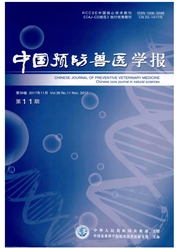

 中文摘要:
中文摘要:
为了弄清2006年在我国南方一些猪场暴发的一种以高热、高发病率和高死亡率为特征的传染病的病因,我们从12个省市48个发病猪场采集临床样品进行了猪繁殖与呼吸综合征病毒(Porcine reproductive and respiratory syndrome virus,PRRSV)的分离鉴定和分子流行病学分析.结果显示从48个猪场样品中均检测出了PRRSV,通过完整的ORF5和部分Nsp2基因序列比较分析发现来自12个省市不同猪场的PRRSV高度同源,而且在Nsp2基因上都有两个相同位点的缺失;从分离的15株PRRSV中选择湖南分离株HuN4人工感染5头60日龄的健康猪,结果5头猪分别在7 d~21 d内全部死亡,感染猪的临床症状和现地所见十分相似.本次试验结果表明新出现的以Nsp2基因部分缺失为特征的PRRSV对猪是高致病性的,可能是2006年大部分猪场暴发“高热综合症”的主要病因.
 英文摘要:
英文摘要:
An emerged highly pathogenic disease, characterized by high and continued fever high-mortality, was occurred in the pigs in main swine industry provinces of mainland China in 2006. To investigate the causative agent of the pandemic disease, we collected clinical samples from 48 pig farms in twelve provinces where suffering the disease for virus isolation and epidemio- logical analysis. The results showed that porcine reproductive and respiratory syndrome virus (PRRSV) was detected by RT-PCR from all samples of 48 pig farms. Sequence comparison of complete ORF5 and partial Nsp2 indicated that all the PRRSVs shared a common feature of two distinctive deletions in Nsp2 region, and the viruses from different geographical locations were highly homologous to each other. To examine the pathogenicity of the emerged PRRSV to pigs, five 60-day-old PRRSV-free piglets were inoculated intranasally with the virus of 2× 10^5.0 TCID50. All the infected pigs were died at 7, 8, 12, 16, and 21 days post inoculation, respectively, the clinical and pathological observations of pigs were similar to that appeared in field investigation. In conclusion, the emerged PRRSV featured by deletions in Nsp2 is highly pathogenic to pigs and is possibly the causative agent of the new wave of PRRS in mainland China, 2006.
 同期刊论文项目
同期刊论文项目
 同项目期刊论文
同项目期刊论文
 期刊信息
期刊信息
